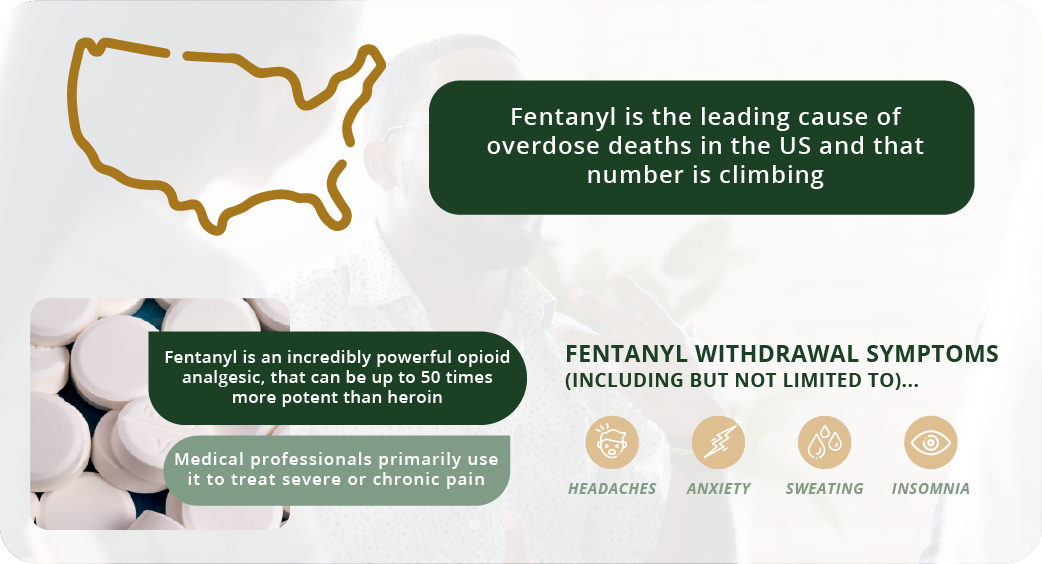For over a decade, the opioid crisis has continued to hit the United States. According to recent research, Fentanyl is the leading cause of overdose deaths in the US and is climbing. Fentanyl is 50 times stronger than morphine. Because of this, there is an increased risk of a fentanyl overdose, which is why the assistance of a fentanyl detox is often needed for addiction.
Fentanyl is part of a group of drugs known as opioids, which are commonly used for severe pain relief, or in instances of chronic pain. Opioids produce relaxation and euphoric feelings in the user. However, when someone develops opioid (or fentanyl) dependence, this can lead to a debilitating form of dependence on the user. It does not take a user long to develop an addiction. This can occur very quickly and only after using the drug a few times. Withdrawal symptoms are quick to follow and extremely uncomfortable, making it difficult to stop use by oneself.
At Magnolia City, our Houston area detox center helps individuals overcome fentanyl withdrawal in a safe and compassionate environment backed by medical staff who utilize evidence-based medical detox practices. Our team helps patients find recovery.
Fentanyl withdrawal symptoms include:
- Extremely strong cravings
- Headaches
- Nausea and vomiting
- Sweating
- Muscle cramps
- Runny nose
- Dizziness
- Anxiety
- Irritability
- Depression
- Insomnia
- Elevated blood pressure

How Long Does It Take to Detox From Fentanyl?
Fentanyl withdrawal can last several weeks or even months. However, most of the more severe withdrawal symptoms peak within the first few days. Typically, withdrawal symptoms last four to twenty days, but in more severe cases, the individual will encounter PAWS, also known as post-acute withdrawal symptoms.
What are PAWs?
PAWs (post-acute withdrawal symptoms) are sets of symptoms that are felt after the initial physical withdrawal symptoms subside. These are felt as the brain is trying to recalibrate after having the substance present for so long. PAWs are psychological in nature, meaning people often feel depression, anxiety, and mood shifts that they don’t really understand. PAWs are common among individuals who have struggled with fentanyl use for an extended period or time, or abused higher doses of fentanyl.
PAWs are temporary, but they can still last for months after detox. That’s why it’s important to attend an addiction treatment facility after medical detox. An accredited treatment program can help individuals manage PAWs and minimize the chance of relapse.
It’s also important to remember that detoxing from fentanyl can be potentially dangerous due to physical symptoms. This is why it is necessary to enter a program with medical supervision and the ability to prescribe medications to alleviate physical symptoms. This means that symptoms are less severe, making it easier to avoid relapse.
What Factors Affect Fentanyl Detox?
In addition, an individual’s specific experience will depend on a variety of factors that include:
- Length of drug abuse or addiction
- Did fentanyl abuse include any other opioids?
- The intensity of drug cravings and fentanyl withdrawal symptoms
- If the person has been in addiction treatment previously
- Presence of mental health or co-occurring disorder
This is not a complete list, but should help the medical staff determine which medications and protocols will be necessary for recovery.
How Does a Fentanyl Detox Program Manage Withdrawals?
Methadone and Buprenorphine
Methadone and buprenorphine can be used to manage withdrawal symptoms during medical detox and can also be used as a long-term medication-assisted treatment. During detox, addiction medicine can be provided to counteract withdrawal symptoms and make them more manageable.
Methadone is a long-acting opioid agonist, meaning that it acts very similarly to fentanyl but without euphoric effects. It helps reduce opioid cravings and blocks the effects of fentanyl on opioid receptors.
Buprenorphine is a partial agonist opioid, which means that it also activates opioid receptors in the brain, but at a much lesser degree than a full agonist. Buprenorphine relieves withdrawal symptoms and counteracts cravings.
Other medications can be prescribed to manage many other symptoms related to detox. This could include medications to manage blood pressure, nausea, diarrhea, or depression. During your initial evaluation, the detox facility will determine which medications are best for your unique situation. You will be monitored during the detox process, and addiction medicine may be adjusted if needed. The goal is to have a detox experience that is free from as much discomfort as possible.
What Can Be Used for Ongoing Opioid Cravings?
Naltrexone works by attaching to opioid receptors in the brain and blocking any other opioids from attaching. This means if someone has taken naltrexone and then subsequently took fentanyl, they would not be able to feel the effects due to the naltrexone blocking those receptors. Naltrexone does not produce any effects on the user and can be a more effective way for individuals to abstain from fentanyl or other opioids.
What Is Fentanyl?
Fentanyl is a powerful opioid analgesic that binds to opioid receptors, causing feelings of euphoria and blocking pain. It is considered extremely dangerous because of its high potency and high rate of addiction. Individuals become addicted to the prescription drug after being prescribed the medication for severe pain. The drug is also frequently mixed into heroin or other drugs, and then sold on the streets, causing more opioid addiction. Fentanyl is classified as a Schedule II controlled substance under the Controlled Substances Act.
Fentanyl is a synthetic (man-made) opioid that is 50 times stronger than morphine. It was originally developed as an anesthesia agent, but it is now being abused recreationally. According to the National Institute on Drug Abuse (NIDA), “Synthetic opioids other than methadone (primarily fentanyl) were the main driver of drug overdose deaths with a 6-fold increase from 2015 to 2020.”
Signs and Symptoms of Fentanyl Addiction
- Mood swings
- Withdrawing from family and friends
- Noticeable changes in social settings
- A decline in hygiene and appearance
- Significant weight loss
- Sunken eyes
- Constipation
- Falling asleep or “nodding out” at inappropriate times.
- Anxiety
- Depression
- Paranoia
- Confusion
- Hallucinations
- Job loss
- Monetary Issues
- Relationship issues
- Failing or dropping out of school
Fentanyl Detox Center Near Houston, Texas
We offer free parking, comfortable rooms, and a friendly staff ready to answer any questions you might have. Our goal is to help our patients get back on their feet by providing them with ongoing support in the best possible environment in which they can begin to heal.
Fentanyl Detox Center in The Woodlands
Our fentanyl detox center is located in Conroe, Texas, near Lake Conroe and The Woodlands, offering easy access to beautiful beaches, wildlife preserves, and serene parks. It is easily accessible for those who are looking for residential fentanyl detox in:
- The Woodlands, TX
- Spring, TX
- Tomball, TX
- Humble, TX
- Aldine, TX
- Atascocita, TX
- Huntsville, TX
- Jacinto City, TX
- Cloverleaf, TX
- West University Place, TX
- Bellaire, TX
- Galena Park, TX
- Channelview, TX
- Katy, TX
- Conroe, TX
Take the next step and help yourself or a loved one to recover from fentanyl addiction now. Learn more about our admissions process today and request a free insurance verification.
FAQs
Just like opioids or opiate detox, detoxing from fentanyl at home is not recommended, and the risk can be life-threatening. It also takes much longer than going into an accredited treatment center. For the best chance at recovery, it’s best to get the appropriate help.
Insurance coverage varies from one plan to another. Some plans cover up to 50% of the cost, while others only provide 10%. Some plans require preauthorization before treatment begins. Others allow you to go directly to treatment.
The insurance company determines what services are covered. The provider must then determine whether or not the patient qualifies for the service. If you have insurance coverage for detox and rehabilitation, please contact Magnolia City Detox to learn how we can assist you.
Yes, detoxing is only the first step in overcoming fentanyl addiction. Our inpatient rehab in the Houston metro area will help you overcome the underlying causes of your addiction and prepare you for life in recovery.
Treatment programs offer a variety of therapy options, relapse prevention planning, and drug addiction programs. Addiction is considered a chronic relapsing disease, but those who enter into a program are more likely to remain in recovery than those who do not.

















